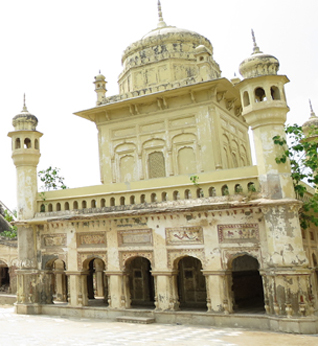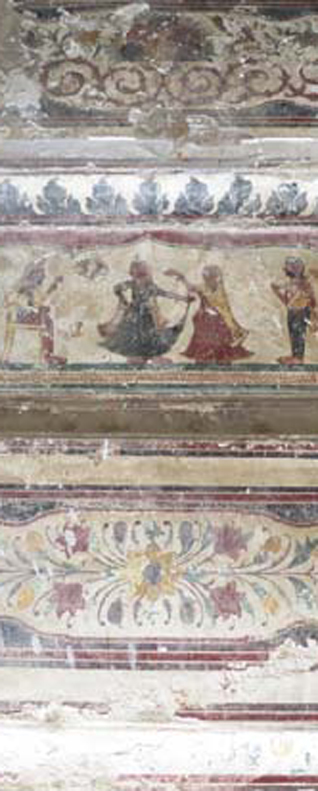Architecture
Dipalpur Fort & Gurdwara:
One of Many Rich Heritage Sites From The Lost Sikh Homeland
OMAR MUKHTAR KHAN
Taking advantage of the long Eid break last month, I along with a couple of friends decided to explore the ancient Dipalpur Fort about a couple of hours drive from Lahore (Punjab, Pakistan).
On reaching Dipalpur, we started inquiring about the whereabouts of the Dipalpur Fort and to our amazement no one had a clue as to what we were talking about -- until a shopkeeper taking us for some ‘documentary-types’ directed us to a small village on Wasawaywala Road, by the name of Bhuman Shah.
After travelling on this scenic road, surrounded by potato and maize fields, for 15 minutes, we reached Bhuman Shah.
To our surprise, it looked like a mini fort with a huge compound divided into residential quarters or haveli, a gurdwara or prayer area and a dharamshala or hostel for visitors.
Presently, except for the gurdwara, local inhabitants are using all other buildings of the compound as residences with limited awareness for heritage conservation.
The haveli and some meditation rooms in the gurdwara appear to be built in the late 18th century. However, the samadhi and prayer hall appear to be newer constructions in comparison to the haveli.
The gurdwara and the two buildings are protected under the Anitquities Act, 1974.
However, the only sign of the government possession of the gurdwara is a huge lock at the main gate -- though both, visitors as well as schoolboys, can enter through one of the broken walls either to explore the amazing gurdwara or play cricket in the main prayer hall, depending on their interests.
The haveli or residential compound is an imposing structure with its own ancient wooden gate. The outer walls are now in dilapidated condition but have intricate carvings and frescos and beautiful arches all around. The walls covered with frescos show various scenes from Sikh history and lore as well as carved embellishments showing human faces, beasts as well as shapes depicting jinns.
The entry to the haveli is restricted to only women as some Pathan families now reside inside it.
The other interesting building is the dharamshala or hostel. The building appears to be built at a later stage when the number of visitors to Bhuman Shah increased. This too is being used by local families as residential quarters.
Locals said that Sikhs come here to pay their respects frequently. The gurdwara has a meditation cell or samadhi in the centre. The samadhi has a Mughal character with tall minarets at all corners probably as a result of centuries of Muslims, Sikhs and Hindus living together in peace and harmony. The samadhi has some amazing frescos on its marble walls with scenes of a royal darbar, hunting expeditions etc. — still quite well preserved.
Some of the marble walls with frescos appear to have been displaced or stolen.
The main prayer hall too is well kept. There is a proper marble stage for the prayer leader as well as a gallery for those in the congregation who cannot find space on the ground floor. The prayer hall was inaugrated in 1910, however, it seems that it is currently being used for some in-house cricket by the local youth.
As the story goes, Bhumia was a 17th century saint born in 1687 in Behlolpur village of Dipalpur. At an early age, he got inducted into the Udasi tradition and was renamed as Bhuman Shah. The tales of his miracles spread to a vast area and earned him a fair share of devotees. Bhuman Shah apparently helped to get released a local Wattoo landlord from prison, using his spiritual powers and, in turn, was awarded a vast landholding by the landlord -- hence the Bhuman Shah village.
Bhuman Shah died in 1762 and throughout his life preached the message of peaceful co-existence and universal brotherhood, earning him not only Sikhs but also Muslim and Hindu as followers.
After the Partition of Punjab in 1947, the descendents of Bhuman Shah fled to Punjab in India and the gurdwara, along with the associated property, became practically abandoned. Some of Bhuman Shah's followers now live in Haryana as well as Dehradun.
It would not be too much to ask from the government to preserve Bhuman Shah and other Sikh and Hindu heritage sites with a proper conservation plan. The government should appoint guides who also act as watchmen at these sites and the local administration as well as tourism departments should run a communication campaign around these heritage jewels scattered all over Pakistan.
On return from Bhuman Shah, we were able to find Dipalpur Fort on our own but that is story for another time.
The author is a development professional with a passion for travelling.
[Courtesy: The News on Sunday. Edited for sikhchic.com]
August 27, 2014
Conversation about this article
1: Sunny Grewal (Abbotsford, British Columbia, Canada), August 27, 2014, 2:51 PM.
You can go into Sikh Punjab and still find mosques that are in pristine condition, regardless of the fact that the main Muslim population resides only in Malerkotla. From my own personal anecdotal evidence I have noticed that mosques are more prevalent in the Doaba region than in Malwa. This could however be incorrect as I am basing it on my limited first-hand knowledge. What is more surprising is that in Doaba you can still find village mosques left over from when Muslims used to live amongst the local communities. In Pakistani Punjab the majority of village gurdwaras were converted into mosques.
2: Sarvjit Singh (Massachusetts, USA), August 28, 2014, 9:11 AM.
Were any mosques in Punjab converted to gurdwaras? In East (Indian) Punjab, newer Muslims are Bihari or from Uttar Pradesh and they don't share the same cultural background as the Malerkotla Muslims.
3: Sunny Grewal (Abbotsford, British Columbia, Canada), August 29, 2014, 12:33 AM.
@3: I believe a few years ago a mosque (at Guru Hargobindpur - Guru ki Maseet) was renovated by the Sikhs and gifted back to the Muslim community. However looking at the fact that there are plenty of mosques from pre-Partition Punjab existing in towns and villages, the same drive to purge the heritage of a different faith was not pursued as zealously by Sikhs as it was by Muslims. [EDITOR: Another well known example - a mosque still stands, fully functional, within the Punjab Police Academy in Punjab and is lovingly tended to every day ... by Sikhs!]
4: Rup Singh (Canada), August 29, 2014, 6:15 PM.
We only have to look at the fact that the foundation stone of Darbar Sahib was laid by Saeen Mian Mir to understand why Sikhs respect and even take care of the places of worship of others.




